The rise of Generative AI (GenAI) for text-to-image creation, like Bing Image Creator, has created new opportunities for people who may lack traditional artistic skills, like myself. For those who struggle with drawing or other creative disciplines, these tools are a game-changer, providing an accessible way to visually express their own creative ideas. Simply by typing a description, anyone can bring to life images that reflect their imagination, whether it’s for personal projects, storytelling, or fun experiments.
Another advantage of Bing Image Creator is its ability to generate diverse and unique visuals quickly. This is especially useful for prototyping and brainstorming, as users can explore a wide variety of concepts in a short amount of time without needing to start from scratch for each new idea. We recently used it for a DBA assignment to quickly create a visualization of our application.
However, despite its benefits, there are significant limitations. One major drawback that I experienced was that achieving a specific, detailed image often requires dozens of attempts. This trial-and-error process can be time-consuming, especially if you have a particular vision in mind. Another common annoyance is the tool’s inability to handle text properly within images. Misspelled words and jumbled letters happen a lot, which means you would have to edit the image, which is time-consuming. These technical flaws can be a barrier for users who need precision in their visuals.
Beyond the technical issues, there is an ethical dilemma. GenAI tools, like Bing Image Creator, are trained on large amounts of data, including artwork by real creators. Using such tools for financial gain raises questions about intellectual property and whether it’s fair to profit from art generated by an AI system that learned from the work of others without compensation. For many, this remains a contentious issue, emphasizing the ongoing debate around AI’s role in creative industries.
While GenAI provides incredible opportunities for personal creativity, it’s important to be mindful of its limitations and the ethical concerns that come with it.


